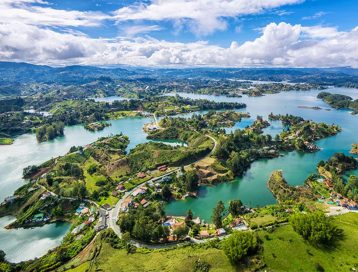LAC: Managing rivers and waterways
In Latin America we work together with local authorities to develop integrated solutions for river training, river regulation and river management that respect and balance the different economic, ecological and societal demands. We seek optimum combinations of hard and soft measures and actively develop nature-based solutions. We apply our unique expertise in assessing both short-term and long-term effects of strategies and interventions, using physics-based models as well as scenario-based policy analyses.

For example, our pre-feasibility study for a new canal in Argentina showed that such a canal could be the backbone of economic development, provided that it is accompanied with investments in new economic zones to produce cargo and reduce the congestion at the ports along the Río Paraná and the Río de la Plata. The results help the government in strategic planning for economic development.
In Ecuador, our analysis of the rivers Daule, Babahoyo and Guayas showed that sedimentation problems at the city of Guayaquil are primarily caused by downstream anthropogenic changes in the estuary rather than by upstream deforestation. This insight helps local authorities in selecting effective interventions.
Other examples of our work
Modelling the Magdalena river and strengthening modelling capacities within CorMagdalena (Colombia)
The assignment entailed the construction of a one-dimensional model including two-dimensional inundation modeling capability for the downstream part of the Rio Magdalena, as well as morphological modelling and water quality modelling for a selected pilot area. The assignment emphasized the capacity building, knowledge transfer, and on-the-job training of the staff of CORMAGDALENA in order to ensure that they will be able to manage, modify, extend, and fully utilize the model(s) after project execution. Contact person: Mohamed Yossef.
Modelling the Mojana Delta with SOBEK 1D-2D (Colombia)
In this assignment of a 1D-2D hydrodynamic model was implemented with two-dimensional inundation modelling capability for the La Mojana region. The model was developed in cooperation between Deltares and Fondo de Adaptación La Mojana Technical Office. The assignment also included capacity building, knowledge transfer, and on-the-job training of the staff of the Technical Office in order to ensure that staff is at the required technical level to manage, modify or extend the model and to perform scenario simulations for the La Mojana region. Contact person: Erik Mosselman.
New Inland Waterways in Argentina (Argentina)
This assignment regarded a pre-feasibility study for the Hidrovía Continental, a new 635 km long multipurpose canal in Argentina. When integrated in broader inland waterway policies, inland waterway support programmes and spatial planning, the canal could become the backbone of regional systems for multimodal transport and integrated water resources. Contact person: Erik Mosselman.
Port of Salaverry siltation (Peru)
A port sedimentation study was performed for Salaverry Terminal Internacional, the operator of the Port of Salaverry in Peru. Data analysis and numerical modelling were used to understand the causes of the port’s sedimentation. Several mitigating measures were proposed and assessed to reduce the maintenance dredging needs of the Port. Contact person: Roderik Hoekstra.
Study on the intrusion and dispersion of salt water in the Panama Canal (Panama)
In this project an analysis was carried out on the intrusion of salt water into the Panama Canal system caused by the operation of both the existing and the new shipping locks, and the dispersion of the intruded salt water in the fresh water canal system was studied. Contact person: Erik Ruijgh.



